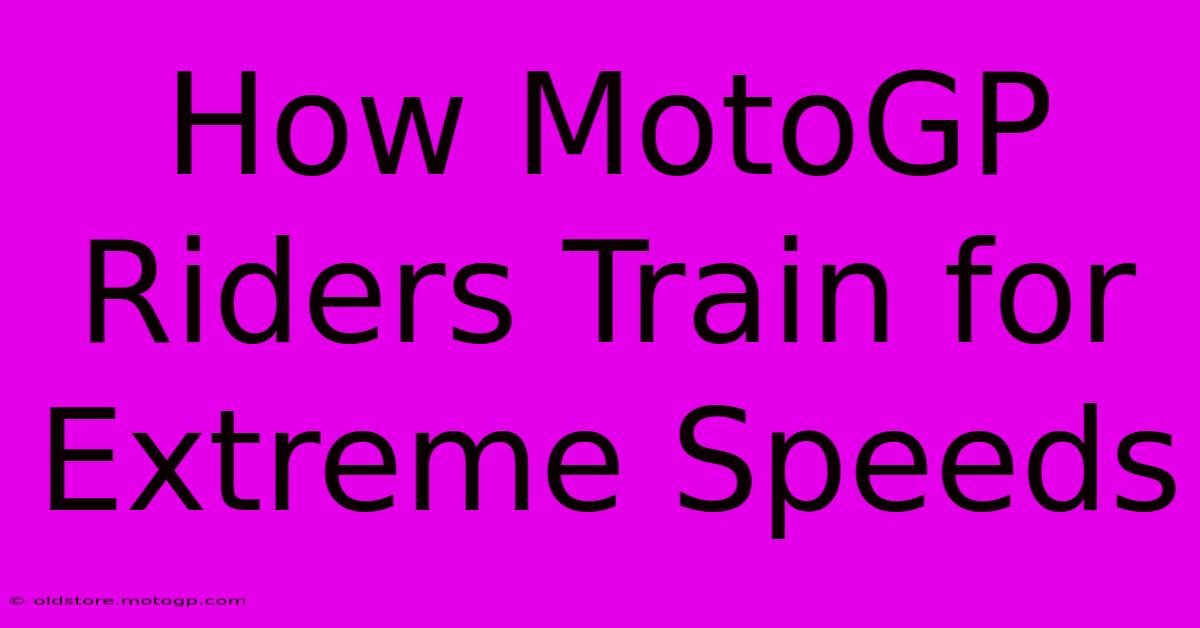How MotoGP Riders Train For Extreme Speeds

Table of Contents
How MotoGP Riders Train for Extreme Speeds
MotoGP racing demands the ultimate from its riders: incredible speed, razor-sharp reflexes, and unwavering focus. Reaching speeds exceeding 200 mph requires more than just natural talent; it necessitates a rigorous and multifaceted training regime. This isn't just about physical fitness; it's about honing a complex interplay of physical, mental, and technical skills. Let's delve into the intense training regimen these elite athletes undertake to conquer the track.
The Physical Foundation: Strength, Stamina, and Flexibility
MotoGP racing is physically grueling. Riders endure intense G-forces, sustained periods of high concentration, and the constant strain of maneuvering a powerful machine. Their training reflects this:
Strength and Conditioning:
- Strength Training: Focus is on core strength – crucial for stability and control during cornering and acceleration – along with upper body strength for handling the bike and lower body strength for endurance and explosive movements. Exercises include squats, deadlifts, plyometrics, and specialized exercises targeting specific muscle groups used in riding.
- Cardiovascular Fitness: Endurance is vital. Races last upwards of 45 minutes, demanding sustained physical exertion. Training involves running, cycling, and swimming to build stamina and enhance oxygen uptake.
- Flexibility and Mobility: Maintaining flexibility is essential to prevent injuries and maximize performance. Regular stretching, yoga, and Pilates are incorporated to improve range of motion and reduce muscle stiffness.
Specialized Training:
- Motocross Training: Many MotoGP riders maintain their motocross skills. Motocross demands intense bursts of speed, agility, and precise control, mirroring aspects of MotoGP racing. This translates directly to improved bike handling and reaction time.
- Gymnastics and Balance Training: Improving body control and balance is paramount. Activities like gymnastics and balance exercises enhance coordination and refine the rider’s ability to react swiftly to unexpected situations on the track.
Mental Fortitude: The Mind Game
The mental aspect of MotoGP racing is equally critical. Riders must maintain extreme focus for extended periods, manage pressure, and react instantaneously to changing track conditions.
Mental Training Techniques:
- Visualization: Riders mentally rehearse races, visualizing every corner, braking point, and overtaking maneuver. This improves muscle memory and reaction time.
- Meditation and Mindfulness: These techniques help riders manage stress, enhance focus, and improve mental resilience.
- Sports Psychology: Working with sports psychologists helps riders develop coping mechanisms for pressure, build self-confidence, and optimize their performance under stressful conditions.
Technical Skills: Mastering the Machine
Understanding the intricacies of the motorcycle is as crucial as physical and mental preparation.
Technical Training:
- Data Analysis: Modern MotoGP utilizes extensive data analysis. Riders review telemetry data to understand their performance, identify areas for improvement, and fine-tune their riding style.
- Simulators: Sophisticated simulators replicate track conditions, allowing riders to practice and perfect their lines without the risks associated with real-world track sessions.
- Bike Setup and Adjustments: A deep understanding of bike setup is essential. Riders work closely with their mechanics to adjust suspension, gearing, and other aspects to optimize performance for different tracks.
Nutrition and Recovery: Fueling the Machine
Maintaining optimal physical condition requires a dedicated approach to nutrition and recovery.
Nutritional Strategies:
- Balanced Diet: A well-balanced diet provides the necessary energy and nutrients for intense training and racing. This typically includes lean protein, complex carbohydrates, and healthy fats.
- Hydration: Staying properly hydrated is critical, especially during training and races.
- Supplementation: Some riders use supplements to aid recovery and enhance performance, though this is always done under the guidance of medical professionals.
Recovery Methods:
- Sleep: Adequate sleep is crucial for muscle recovery and optimal cognitive function.
- Active Recovery: Light activities like cycling or swimming aid in recovery without placing undue stress on the body.
- Massage Therapy: Massage helps to reduce muscle soreness and improve circulation.
In conclusion, the training regimen of a MotoGP rider is a comprehensive endeavor, demanding dedication, discipline, and a holistic approach to physical, mental, and technical preparation. It's a testament to the extreme demands of this high-octane sport and the incredible dedication of its athletes. The combination of intense physical training, mental fortitude, technical mastery, and meticulous attention to nutrition and recovery allows these riders to push the boundaries of speed and precision on the world's racetracks.

Thank you for visiting our website wich cover about How MotoGP Riders Train For Extreme Speeds. We hope the information provided has been useful to you. Feel free to contact us if you have any questions or need further assistance. See you next time and dont miss to bookmark.
Featured Posts
-
Get Your Austin Grand Prix Parking Lot Tickets Before They Re Gone
Feb 23, 2025
-
Moto2 Bikes Designed For Champions
Feb 23, 2025
-
Austin F1 Decoding The Qualifying Results
Feb 23, 2025
-
Racing Royalty Crowning The Best Motorcyclist Of All Time
Feb 23, 2025
-
Moto Gp Helmets The Riders Best Friend
Feb 23, 2025
